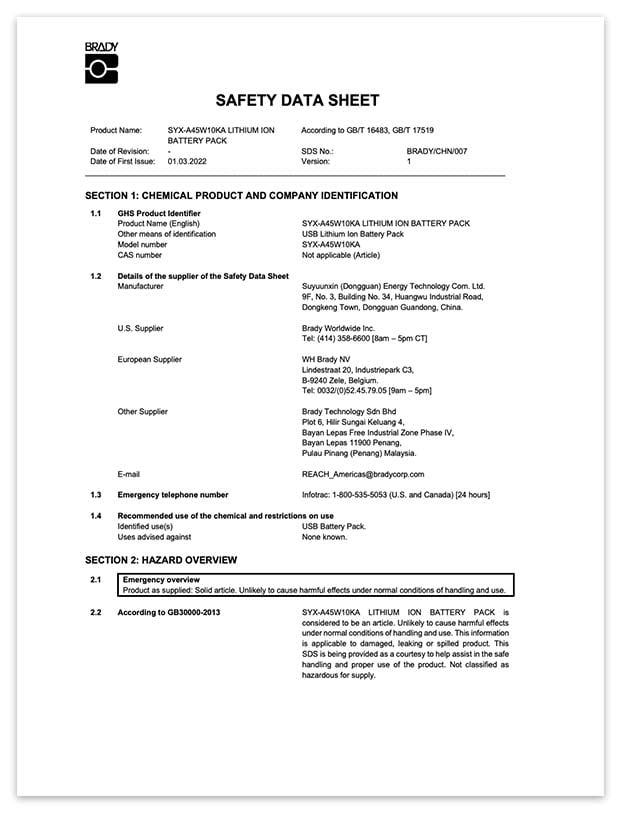What Is a Safety Data Sheet? (SDS): What You Need to Know
Workplace safety cannot and should not be underemphasized. It's not simply about avoiding accidents and injuries; it's about creating an environment where employees feel safe and can perform at their best. And for a bevy of industries, one safety initiative is compliance with the Hazard Communication Standard (HCS) from the Occupational Safety and Health Administration (OSHA).
Composed of many elements, one area of compliance with OSHA’s HazCom Standard regards the usage of Safety Data Sheets (SDS). In essence, these sheets serve as a safety net, providing critical information to ensure the safe handling and use of hazardous substances in the workplace. For certain organizations, understanding and correctly implementing SDSs is a significant component of OSHA compliance and plays a key role in maintaining a healthy and safe work environment.
What is a safety data sheet?
Safety Data Sheets(PDF opens in a new tab) are comprehensive documents containing detailed information about a specific substance or mixture used in workplaces. Initially developed by the United Nations, they are an integral part of the Globally Harmonized System of Classification and Labelling of Chemicals (GHS)(opens in a new tab). According to OSHA, an SDS includes(PDF opens in a new tab) “information such as the properties of each chemical; the physical, health, and environmental health hazards; protective measures; and safety precautions for handling, storing and transporting the chemical.”
SDSs provide employers, employees, emergency responders and healthcare professionals with the information necessary to handle these substances safely and respond effectively during emergencies. These sheets can help prevent workplace accidents and illnesses related to exposure to hazardous chemicals
For instance, if a spill or accident occurs, the SDS provides specific instructions on what protective measures should be taken, what equipment can safely be used and how to clean up the materials properly. This allows for quick, informed decisions that could potentially save lives and minimize damage.

Who needs to keep safety data sheets?
According to OSHA's Hazard Communication Standard (HazCom), several types of organizations are required to maintain Safety Data Sheets. These organizations generally fall under four main categories:
- Chemical manufacturers produce chemicals and must develop SDSs for each hazardous chemical they make or import. The SDSs must be given to the distributor or employer upon the first shipment of the chemical.
- Importers are businesses that purchase chemicals from foreign manufacturers. Like chemical manufacturers, importers must ensure they have an SDS for each hazardous chemical they import, which must be provided to the distributor or employer with the first shipment.
- Distributors act as the middlemen between manufacturers or importers and the employers who use the chemicals in their operations. Distributors must ensure that the appropriate SDS accompanies every container of hazardous chemicals they ship.
- Employers using hazardous chemicals must maintain SDSs. Each chemical requires an accessible SDS for employees during their shifts.
Without SDSs, employers and employees are exposed to undue risk.
What are the SDS format requirements?
Safety Data Sheets (SDS) are globally recognized and formatted in a specific way. This standardization is crucial for the consistent presentation of vital safety information. It facilitates easy access and understanding of chemical handling instructions for employees and safety personnel.
The new SDS format and system replaces the older Material Safety Data Sheets (MSDS) format. While MSDS formats might differ from source-to-source within a country based on national requirements, the newer SDS format is universally recognized.
According to the OSHA brief on SDSs cited above, an SDS typically consists of 16 sections, each providing specific details about the chemical and its properties:
- Section 1-8 provide general information on chemical identification, hazards, composition, safe handling practices, and emergency control measures.
- Sections 9-11 and 16 provide technical and scientific details, including information about physical and chemical properties and exposure control.
- Sections 12-15, consistent with the GHS, are included in the SDS, but OSHA does not enforce their content as other agencies handle them.
To comply with the HazCom Standard, new Safety Data Sheets must include section numbers, headings and associated information. OSHA recommends organizing the pages alphabetically by product name.

Guide to SDS sections
The following 16 sections are typically present in an SDS.
Section 1: Identification
This section contains the product identifier used on the label, as well as other common names or synonyms for the substance. It also includes contact details like the manufacturer's name, address, phone number and the emergency helpline.
Section 2: Hazard(s) identification
This section identifies the hazardous material presented on the label. It includes hazard classification, signal words, hazard statements, precautionary statements and pictograms. Hazmat labels, such as those detailed in the NFPA 704 diamond labeling guide, provide important information about these hazards.
Using hazardous material labels and printing can help you stay compliant with OSHA's HCS and ensure the safe handling of hazardous substances in your workplace.
Section 3: Composition/Information on ingredients
This section tells you all about the ingredients present in the product mentioned on the SDS. It covers everything from impurities to stabilizing additives. You'll find information on substances, mixtures and any chemicals that are considered a trade secret. Appropriate chemical labels can help in identifying these ingredients.
Section 4: First-aid measures
This section explains how to initially care for someone who has been exposed to the chemical, even if you are not trained to respond.
Section 5: Fire-fighting measures
This section offers suggestions on how to tackle a fire caused by the chemical. It covers suitable extinguishing techniques, equipment and potential hazards associated with the fire.
Section 6: Accidental release measures
This section provides suggestions for how to handle spills and leaks — known officially as “releases.” It covers effective containment and cleanup techniques to address these situations. It's important to note the role of lockout tagout devices and lockout tagout tags in preventing accidental releases by isolating energy sources.
Section 7: Handling and storage
This section provides guidance on the safe handling practices and conditions for secure storage of chemicals such as temperature, ventilation and incompatible materials.
Section 8: Exposure controls/Personal protection
This section indicates the measures that need to be taken to protect employees and limit their exposure to harmful substances, including establishing exposure limits and the use of personal protection (PPE). Personal protection can include gloves, aprons and safety glasses to keep workers safe.
Section 9: Physical and chemical properties
This section includes the following details on the physical and chemical properties of the substance/mixture:
With this knowledge, employees can properly understand how to recognize and handle chemicals properly.
Section 10: Stability and reactivity
This section covers the reactivity hazards of the chemical and provides information on its stability. It includes details about potential hazardous reactions, things to steer clear of (like static discharge, shock or vibration) and materials that are not compatible.
Section 11: Toxicological information
Section 11 contains information about the toxicology and health impacts of exposure to hazardous substances. You’ll also find details about symptoms related to exposure, as well as the immediate, delayed and chronic effects from both short- and long-term exposure.
Non-mandatory sections 12-16
The last five sections of the Safety Data Sheet are not mandatory under OSHA’s HazCom Standard. However, these sections may still contain valuable information, especially for those responsible for managing the storage, transportation and disposal of the chemical.
Here's a brief overview:
- Section 12 - Ecological Information: This section provides information to assess the environmental impact of the chemical release. It includes toxicity test data on aquatic and terrestrial organisms, potential for persistence and degradation, and bioaccumulation test results.
- Section 13 - Disposal Considerations: According to the OSHA brief on SDSs cited above, section 13 should include handling directions on how to dispose of, recycle or reclaim chemicals and their containers. It should also advise on appropriate equipment and potential environmental contamination.
- Section 14 - Transport Information: This section offers guidance on classifying and shipping hazardous chemicals by road, air, rail, or sea. It includes information like UN number, proper shipping name, transport hazard class, packing group (if applicable), environmental hazards, bulk transport, and special transport precautions.
- Section 15 - Regulatory Information: This section highlights product-specific safety, health, and environmental regulations not found on the SDS. It includes national and/or regional regulatory information for the chemical or mixtures.
- Section 16 - Other Information: This section shows the preparation date or last revision of the SDS. It may also mention changes from the previous version.
Even though OSHA does not require these sections, they can still provide essential information for other international bodies, so it's a good practice to complete them.
Safety data sheet example
An excellent example of a Safety Data Sheet can be found in this sample provided by OSHA(PDF opens in a new tab). It includes all 16 sections, from identification to other information, providing comprehensive details about a hypothetical hazardous chemical.
Some notable points in this example include:
- A clear layout and easy-to-understand language are used throughout the document.
- The hazard identification section provides detailed information on classification, signal words, and hazard statements.
- Including mandatory and non-mandatory sections shows the breadth of information that can be included in an SDS.
This example is an excellent reference for understanding what information an SDS should contain and how it should be presented.
How to use safety data sheets for workplace safety
SDSs are not just documents to be stored in a binder; they're crucial tools for maintaining a safe and healthy workplace. Here's how they can be effectively utilized:
- Training employees: All employees who may come into contact with hazardous chemicals must understand how to read and use an SDS. Training programs and workplace safety culture resources can help ensure that all staff are knowledgeable and confident in using SDSs.
- Implementing safety measures: The information in the SDS should form the basis of safety measures implemented in the workplace. For example, the personal protective equipment recommended in the SDS should be provided to all relevant workers.
- Maintaining and updating SDSs: SDSs should be easily accessible in the workplace, and procedures should be in place to update them whenever new information becomes available. Regular reviews and workplace safety inspection resources can help ensure that SDSs remain current and accurate.
Managing SDSs properly and following their recommendations can make a real difference in workplace safety. It means fewer accidents, lower workers' compensation costs and a more productive and confident workforce. Plus, it's a legal requirement under OSHA regulations. So, investing time and resources in proper SDS management isn't just a good practice; it's good for business.

